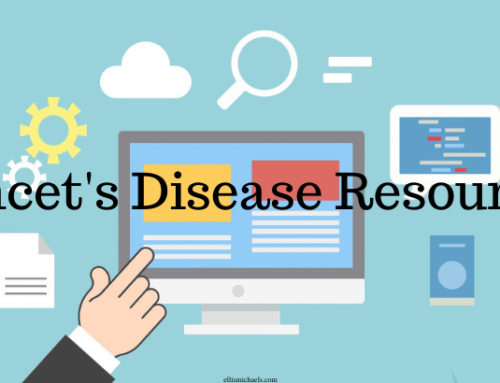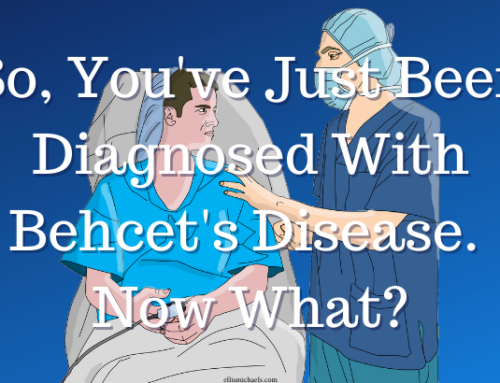In this article, we’re going to talk about a fascinating plant that goes by a lot of names: weed, herb, Mary Jane, tree, hemp, wacky tobacky, green gold, dope, cheeba, ganja, marijuana, flower, pot, sinsemilla, skunk, grass, reefer – to name a few. But to avoid confusion while discussing the effects this medicinal plant has on Behcet’s disease, I’ll mostly reefer – excuse me, I mean refer – to it as cannabis.
Cannabis isn’t something many doctors recommend to their Behcet’s patients. It is, however, something a lot of people diagnosed with Behcet’s disease use to treat some of its symptoms. I’m one of those people. Cannabis has given me relief not only from several Behcet’s symptoms, but also from several side effects of drugs used to treat the disease.
In this article, we’re going to discuss the use of cannabis in people diagnosed with Behcet’s disease. But first, let’s take a quick look at what exactly cannabis is.
What Is Cannabis?
Table of Contents
Cannabis is a type of flowering plant that is indigenous to Central Asia and India and has been used since prehistoric times.1 While the term medical marijuana is relatively new, the medicinal properties of cannabis (some of them, at least) were known by the ancient Greeks – and so were some of its recreational effects.2 Since then, cannabis use gradually spread around the world. And today it’s the fourth-most-popular recreational substance worldwide behind only alcohol, caffeine, and tobacco.3
It’s no secret that smoking weed can make you feel good. People have been using cannabis for its recreational effects for millennia. This is because of the dozens of cannabinoids it contains. These are substances found in the plant that bind to certain receptors in the brain. And the same cannabinoids that cause cannabis’s recreational effects are also responsible for its medicinal properties.
While cannabis contains over 100 cannabinoids, there are a few in particular known to be responsible for most of its effects.4 In particular are THC (delta-9-tetrahydrocannabinol) and CBD (cannabidiol). THC is known to be the main psychoactive cannabinoid. CBD, while generally thought of as non-psychoactive, can have anxiolytic (anti-anxiety) and other effects.
 Cannabis can be consumed in a number of forms. Most commonly, it is either smoked, vaped, or eaten. Even though many of cannabis’s medicinal effects have been known for centuries, the plant was banned in 1970 under the Controlled Substances Act for purely political reasons. But in 1996, California became the first state to legalize medical marijuana.5 Fortunately, it wasn’t the last. As of this writing, 36 states have legalized medical marijuana and 15 have legalized recreational use.6
Cannabis can be consumed in a number of forms. Most commonly, it is either smoked, vaped, or eaten. Even though many of cannabis’s medicinal effects have been known for centuries, the plant was banned in 1970 under the Controlled Substances Act for purely political reasons. But in 1996, California became the first state to legalize medical marijuana.5 Fortunately, it wasn’t the last. As of this writing, 36 states have legalized medical marijuana and 15 have legalized recreational use.6
That’s just a brief overview of what cannabis is. However, there are plenty of resources out there if you want to learn more. A good place to start would be NORML’s website. For decades, they’ve been fighting for the rights of patients and potheads alike. Now that we’ve taken a brief look at this interesting plant, let’s discuss cannabis and Behcet’s disease.
Cannabis and Behcet’s Disease
For me, cannabis has been a game changer. I was diagnosed with Behcet’s disease back in 1997 and have been on dozens of prescription drugs over the years including painkillers (opioid an non-narcotic), anxiolytics, antidepressants, muscle relaxers, sleeping pills, and more. Nowadays, I don’t need most of those things because I found something both safer and more effective: weed.
But I’m not the only one. I’ve spoken with dozens and dozens of others with the diagnosis who agree that Behcet’s disease and weed go together like peanut butter and jelly. Here are just some of the things we’ve found it can help with:
 Various types of pain
Various types of pain- Loss of appetite
- Insomnia/sleep
- Anxiety/relaxation
- Depression/mood
- Nausea/upset stomach
I should mention that it’s not just Behcet’s sufferers who’ve told me they use cannabis for their illness. People diagnosed with a wide variety of autoimmune diseases regularly use cannabis to help with everything listed above and more. Just off the top of my head, I’ve heard positive things about cannabis from people diagnosed with Crohn’s, multiple sclerosis (MS), lupus, fibromyalgia, Graves’, Guillain-Barre, rheumatoid (and other types of) arthritis, peripheral neuropathy, and other autoimmune diseases.
Aside from some of the actual symptoms of Behcet’s, I also use cannabis to relieve some side effects of the prescription meds I’m on for the disease. For example, I’m currently prescribed azathioprine (Imuran) and apixaban (Eliquis). When I first went on them, they both made me very nauseous. Fortunately, over time the nausea got less severe and less frequent to the point where it’s quite rare now. But occasionally it still happens. And when it does, a little vitamin THC always knocks it right out. Even when I first went on those meds and the nausea was severe, cannabis always made it much better. If you’d like to know more about what it’s like having Behcet’s, I wrote a post about it: What Is It Like Having Behcet’s Disease?
Cannabis For Chronic Pain
This is one of the most common reasons I’ve heard from people who use cannabis for Behcet’s disease. It’s no secret that Behcet’s can be a very painful illness. Between the oral ulcers, genital ulcers, arthritis, various skin conditions, and other symptoms, pain is no stranger to most Behcet’s sufferers. Personally, it’s something I’ve become intimately familiar with over the years.
 Since Behcet’s is so rare, especially in the United States, it’s not surprising that the scientific community hasn’t looked at the effect cannabis has on the disease directly. A PubMed (worldwide database of scientific journals) search revealed exactly zero results for Behcet’s and cannabis (I tried a number of other keywords, too, like marijuana, CBD, THC, etc.). However, studies have been done exploring the link between cannabis and chronic pain.
Since Behcet’s is so rare, especially in the United States, it’s not surprising that the scientific community hasn’t looked at the effect cannabis has on the disease directly. A PubMed (worldwide database of scientific journals) search revealed exactly zero results for Behcet’s and cannabis (I tried a number of other keywords, too, like marijuana, CBD, THC, etc.). However, studies have been done exploring the link between cannabis and chronic pain.
A scientific review published in 2018 found that cannabis is effective for the treatment of chronic pain in adults.7 This review also found moderate evidence that cannabis can improve short-term sleep problems for people with chronic pain. Lastly, the researchers noted that cannabis has the potential to reduce opioid consumption. The results of this review are consistent with everything I’ve experienced and heard from others with autoimmune diseases.
Cannabis For Anxiety and Mood
Chronic pain might be the main reason people with Behcet’s and other autoimmune diseases use cannabis, but it’s not the only one. Lots of people also use it to reduce anxiety and improve mood. Personally, I find that cannabis usually helps with both. It often puts me in a better mood, especially if I’m in a bad one to begin with. And I also find that cannabis helps with certain kinds of anxiety. It breaks up my thought patterns, allowing me to slow the ol’ noggin down a little bit.
 What does the science have to say about cannabis’s ability to improve mood and reduce anxiety? While the research that has been done looks promising, more is definitely needed. Fortunately, now that cannabis use is more accepted and the laws are changing, lots of interesting cannabis research is underway. But what about the research that has been done?
What does the science have to say about cannabis’s ability to improve mood and reduce anxiety? While the research that has been done looks promising, more is definitely needed. Fortunately, now that cannabis use is more accepted and the laws are changing, lots of interesting cannabis research is underway. But what about the research that has been done?
A 2017 review published in the scientific journal Depression & Anxiety looked at how effective cannabis is at treating mood-and-anxiety disorders.8 This review found some evidence to support the use of CBD for social anxiety and a synthetic cannabinoid similar to THC (nabilone) for generalized anxiety disorder (GAD). Cannabis’s effect on mood is less clear. Some research shows that it can improve mood in depressed patients while other research shows that it can make depression worse.
A lot more high-quality, placebo-controlled studies are needed before we’ll know for sure how cannabis affects mood and anxiety. But there is some evidence to support its use for these purposes. And there are countless anecdotal reports of people getting relief from their depression and anxiety by using cannabis.
Behcet's Disease Uncensored (BDU) is a podcast to discuss this rare illness.
Behcet's doesn't censor itself when it attacks our bodies. So why should we censor ourselves when discussing it?
Listen to BDU on Spotify or wherever you listen to podcasts.
Cannabis For Autoimmune Diseases
While Behcet’s is unique in many ways, it has a lot in common with other autoimmune diseases. Since blood vessels can get inflamed anywhere in the body with Behcet’s, it’s especially similar to systemic autoimmune diseases like lupus and multiple sclerosis. Although no scientific papers have been published discussing the use of cannabis for Behcet’s, there have been some that discuss cannabis use for other autoimmune diseases. Let’s take a look at a few of these studies.
 A 2011 study looked at the effect cannabis had on patients diagnosed with fibromyalgia.9 This disease (sometimes simply referred to as fibro) is characterized by chronic pain, tiredness, sleep problems, and more. This study compared 28 cannabis-using fibromyalgia patients and 28 non-using patients. The results showed that cannabis had a beneficial effect. Among those benefits were reduced pain and stiffness, increased relaxation, and improved sense of well being.
A 2011 study looked at the effect cannabis had on patients diagnosed with fibromyalgia.9 This disease (sometimes simply referred to as fibro) is characterized by chronic pain, tiredness, sleep problems, and more. This study compared 28 cannabis-using fibromyalgia patients and 28 non-using patients. The results showed that cannabis had a beneficial effect. Among those benefits were reduced pain and stiffness, increased relaxation, and improved sense of well being.
Crohn’s disease is an autoimmune condition that causes inflammation in the gastrointestinal (GI) tract. It’s a type of inflammatory bowel disease (IBD) that can cause abdominal pain, diarrhea, weight loss, and more. Behcet’s can also affect the GI tract. A 2017 study looked at the effect cannabis oil had on patients diagnosed with Crohn’s disease.10 After 8 weeks, the participants in the cannabis group had a much higher quality of life (QOL) score than the participants in the placebo group.
A 2006 study looked at the effect that a cannabis extract (Sativex) had on pain in patients with rheumatoid arthritis (RA).11 This is an autoimmune disease that causes inflammation in joints, leading to painful swelling and stiffness. Arthritis is also a common symptom of Behcet’s disease. In this study, 58 RA patients were either given Sativex or a placebo. After 5 weeks of treatment, the participants given Sativex showed a significant improvement in pain while moving, pain while at rest, and in sleep quality.
Conclusion
While the use of cannabis hasn’t been directly studied in people with Behcet’s disease, the studies that have been done on other autoimmune disorders are encouraging. Between those studies and the numerous anecdotal reports of Behcet’s patients being helped by cannabis, it’s definitely something worth considering if you’ve been diagnosed. However, cannabis isn’t for everyone. Some people don’t like the way it makes them feel. And I can relate.
 Even though I love cannabis now, I haven’t always. As a teen, I smoked occasionally. It usually made me feel goofy and hungry. But once I got into my 20’s, every time I smoked I’d get super anxious. So naturally, I stopped. Then in my early 30’s when I gave up alcohol, I decided to give weed another try. A couple of puffs made my anxiety wash away, my mood improve, and helped immensely with both pain and sleep.
Even though I love cannabis now, I haven’t always. As a teen, I smoked occasionally. It usually made me feel goofy and hungry. But once I got into my 20’s, every time I smoked I’d get super anxious. So naturally, I stopped. Then in my early 30’s when I gave up alcohol, I decided to give weed another try. A couple of puffs made my anxiety wash away, my mood improve, and helped immensely with both pain and sleep.
If you’re diagnosed with Behcet’s disease but don’t like the way cannabis makes you feel, maybe try CBD. It comes in a variety of forms and is considered non-psychoactive. I know a lot of people with a variety of autoimmune diseases who use CBD for pain, anxiety, and more. Personally, I don’t get much out of CBD alone. But I do from THC alone and from cannabis as a whole. It helps my mood, anxiety, sleep, appetite, and more. I hope you’re also one of the many Behcet’s sufferers who find some relief from this wacky weed.
If you’re interested, you can read my full story here: Finding Happiness Through Pain and Embarrassment: My Life With Behcet’s Disease – A Memoir.
Join the Ellis Michaels mailing list to get notified about new Behcet's disease articles and publications, up-to-date news and info about this rare illness, and more.
References
1Lambert, D. (2009). Cannabinoids in nature and medicine. Zurich: Helvetica chimica acta.
2Butrica, J. (2008). The medial use of cannabis among the Greeks and Romans. Journal of Cannabis Therapeutics, 2: 51-70.
3Cannabis. (n.d.). Wikipedia. Retrieved November 19, 2020 from https://en.wikipedia.org/wiki/Cannabis
4Campos, A., Moreira, F., Gomes, F., et al. (2012). Multiple mechanisms involved in the large-spectrum therapeutic potential of cannabidiol in psychiatric disorders. Philosophical Transactions of the Royal Society of London, 367(1607):3364-78.
5Pacula, R., Chriqui, J., Reichmann, D., et al. (2002). State medical marijuana laws: understanding the laws and their limitations. Journal of Public Health Policy, 23(4):413-39.
6State medical marijuana laws. (2020, Nov. 10). National Conference of State Legislators. Retrieved November 19, 2020 from https://www.ncsl.org/research/health/state-medical-marijuana-laws.aspx
7Romero-Sandoval, E., Fincham, J., Kolano, A., et al. (2018). Cannabis for chronic pain: challenges and considerations. Pharmacotherapy, 38(6):651-62.
8Turna, J., Patterson, B., & Van Ameringen, M. (2017). Is cannabis treatment for anxiety, mood, and related disorders ready for prime time? Depression & Anxiety, 34(11):1006-17.
9Fiz, J., Duran, M., & Capella, D. (2011). Cannabis use in patients with fibromyalgia: effect on symptoms relief and health-related quality of life. PLoS One, 6(4).
10Naftali, T., Schlieder, L., & Konikoff, F. (2017). The effect of cannabis on Crohn’s disease patients. International Association of Cannabis Medicine (IACM).
11Blake, D., Robson, P., Ho, M., et al. (2006). Preliminary assessment of the efficacy, tolerability, and safety of a cannabis-based medicine (Sativex) in the treatment of pain caused by rheumatoid arthritis. Rheumatology (Oxford), 45(1):50-2.








Leave a Reply